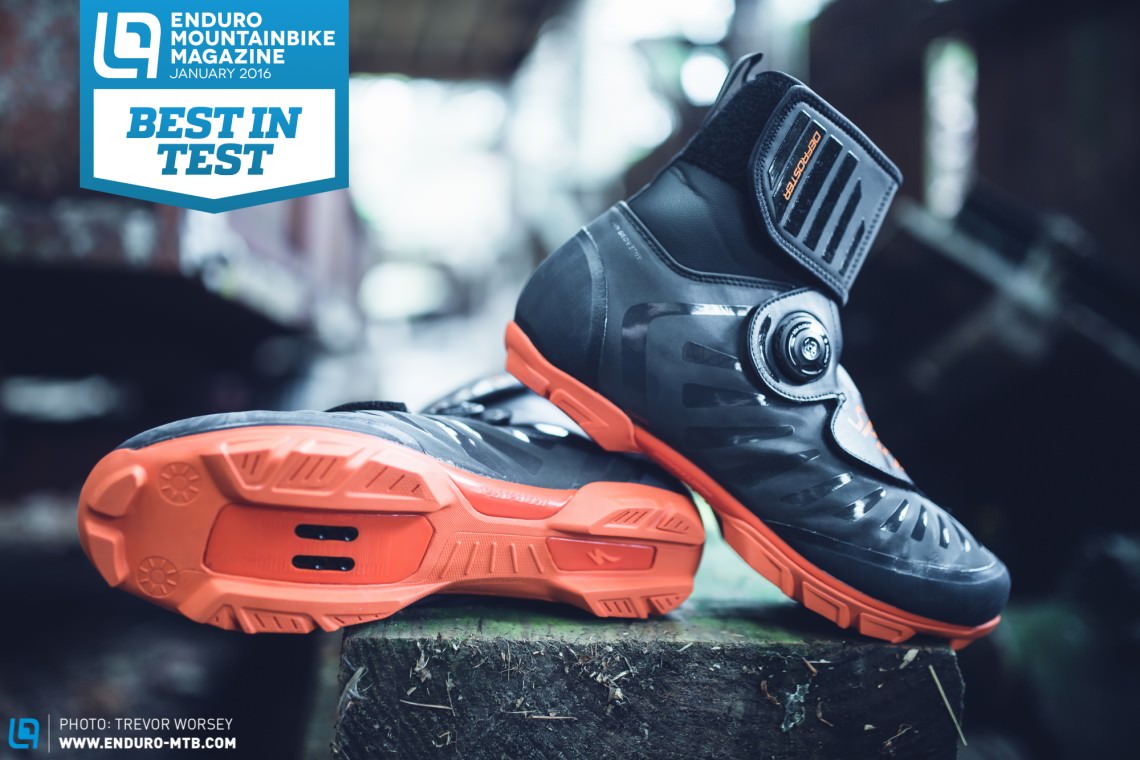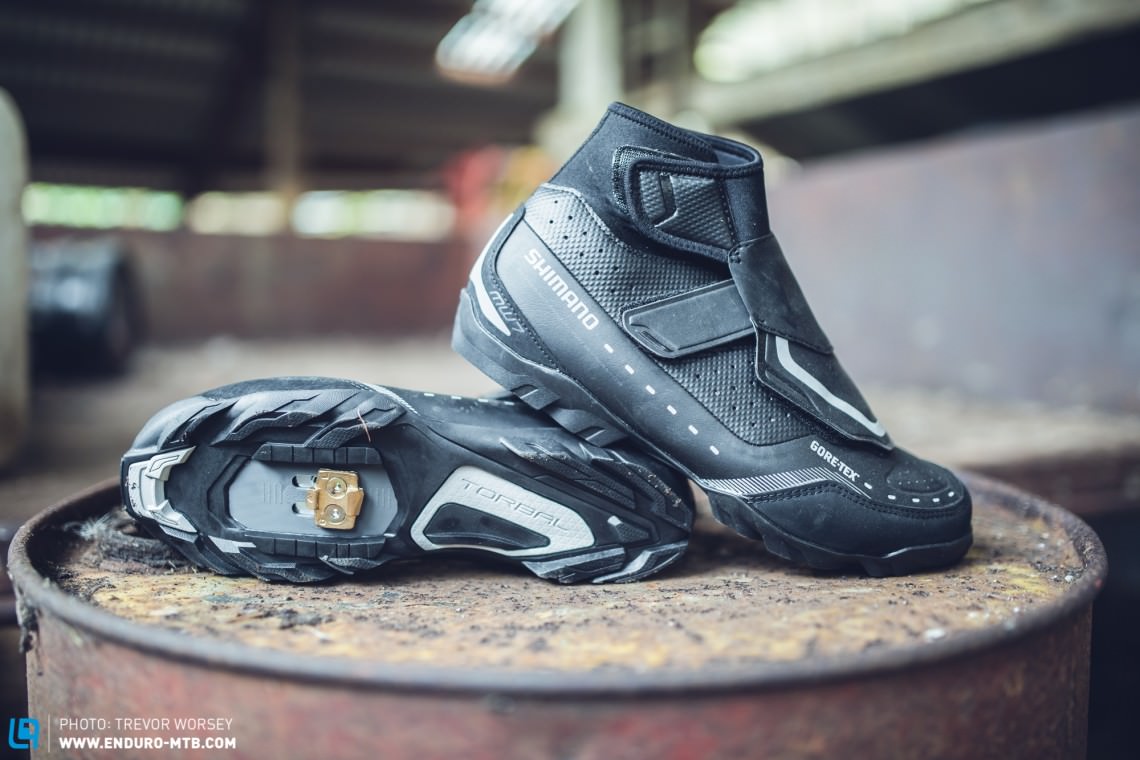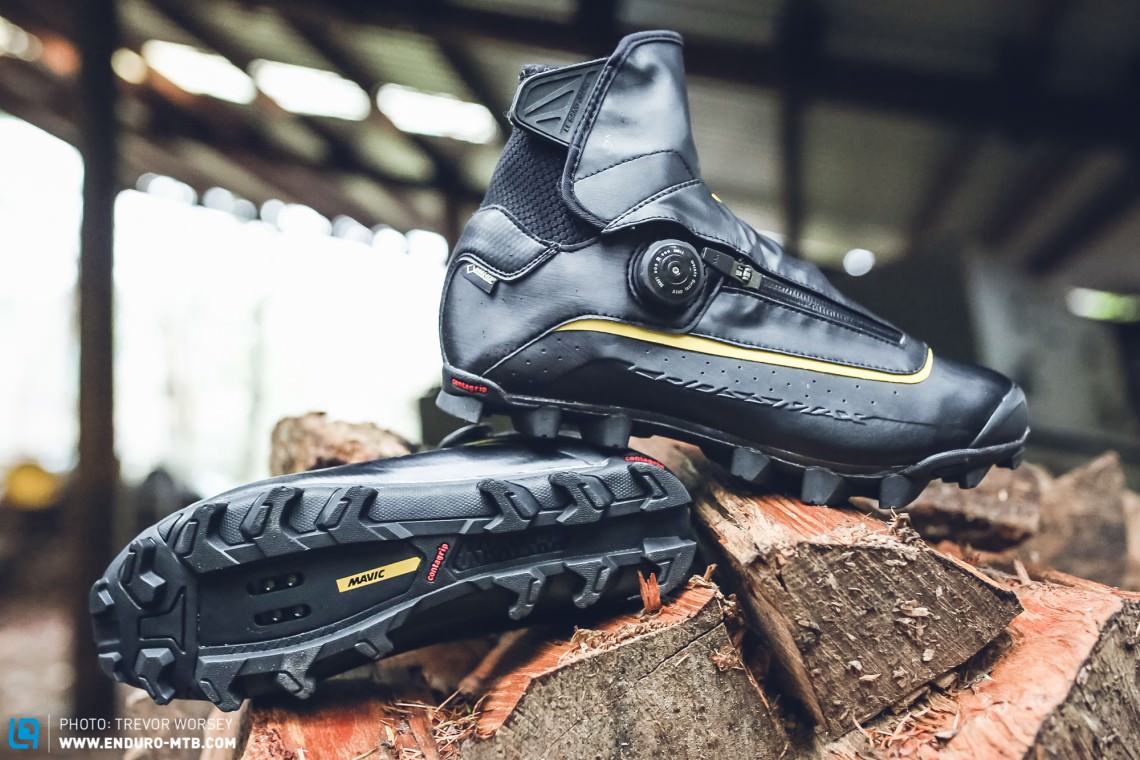When snow lies thick on the ground and the temperatures are so cold that you are not sure if your fingers are still alive, riding is often the last thing on your mind. But winter can be a great playground if you have the right gear, railing muddy ruts and exploding puddles is great fun; freezing cold and wet feet are less so! We tested four of the leading mtb winter shoes to see which could handle the worst winter could bring.

What Makes Great MTB Winter Shoes?
Unless you are lucky enough to live near the equator, a proper mtb winter shoe will see you enjoying long rides throughout the entire year without feeling like your feet are going to drop off. The main functions of winter shoes are to keep your feet dry and warm, and so it’s imperative that they are fully waterproof. The best shoes will feature a trusted waterproof membrane like Gore-Tex, and have a high waterproof cuff to stop spray and rain from seeping into the shoe from the top. Lace holes should be covered with a spray guard and the seams should be sealed. Importantly the shoe should contain enough insulation to fight off the chill without feeling bulky or clumsy. The sole needs to be aggressive enough for hiking in wet mud so look for pronounced studs that will bite into the grime. The latest mtb winter shoes feature a Boa retention system which allows more precise adjustment of fit, but, more importantly, allows you to adjust the fit while keeping your thick winter gloves on. We hand-picked four of the leading models and put them to the test in a tough UK winter.
The Winner: Specialized Defroster Trail

Straight out of the box the seamless construction of the Specialized Defroster Trail shoes and the high neoprene cuff certainly look ready to do battle with the elements. The Boa S4 dial makes getting into the shoes very easy, and in combination with the velcro closure, we found it easy to reach an even, secure and very comfortable fit with lots of room in the toe box though those with slim feet may find the top of the shoe a little baggy. The heel hold is very good and we liked that the Boa dial is easily adjustable on the trail, even with thick winter gloves on. Aggressive riders will like the supportive, lightweight upper and there is plenty of fore and aft adjustment for the cleats. We did find that if we accidentally unclipped, the hard fibre reinforced nylon outsole didn’t offer a lot of grip on the pedal and the same was true when hiking. The tread is not quite aggressive enough for sure footing on steep hikes.
Where the Defrosters excel is when it comes to keeping out the cold. The Thinsulate 400 lining is impressively warm and the high neoprene collar kept us toasty even when the temperatures plummeted well below zero. The waterproof membrane kept all spray and rain outside of the shoes and the only water we experienced was that running down our legs on long rides. After many hard wintery rides, they are wearing well and clean up perfectly with the jetwash. The Defroster Trails are nice and light for mtb winter shoes and dry real fast which is perfect for those who ride daily. Offering a comfortable fit and unrivalled warmth, the Specialized Defrosters were the first shoe to get picked by our test team in bad weather and take the win for excellent winter performance, we just wish they had a more aggressive sole.
For more information on the Specialized Defroster Trail head over to the Specialized website.
Runner Up: Shimano MW7

The Shimano MW7 is perhaps the most versatile shoe in the test, offering enough protection for the worst that winter can offer while breathing well enough to be suitable for all-year-round use. The full Gore-tex liner proved impermeable in the ‘stand in a stream’ test and the comfortable high cut cover did an excellent good job of stopping water driving up into the laces when it was raining hard. The fit of the shoe is extremely comfortable and seemed to suit most of our testers, but the supplied insoles were a little thin for some tastes.The TORBAL midsole felt very positive on the pedals and was the preferred shoe of more aggressive riders who commented on the superior power transfer and lightness. In really cold conditions we did find that we were using thicker socks than in the Northwave and Specialized mtb winter shoes, and with the conventional thin lace and velcro closure, we could not get as precise and secure a fit as those with a Boa system. We would also have liked to see more aggressive sole for hiking in mud as the small lugs did not provide a lot of traction, they did feel great on the pedals though. Overall the Shimano MW7 is a solid and comfortable shoe, better suited to year-round wet weather riding for riders who seek a comfortable but high performance fit.
For more information on the Shimano MW7 head over to the Shimano website.
MAVIC Crossmax SL Pro Thermo

The MAVIC Crossmax SL look aggressive straight out of the box and that is mirrored in their feel on the pedals. Lightweight and comfortable the shoes have a much thinner and more sensitive feel on the foot and the high lace shield can hardly be felt. With a Gore-tex liner and neoprene ankle cuff the shoes have excellent weather protection, but we found that the waterproof zip, although solid was susceptible to jamming with trail debris. The Boa closure system is the best on the market, ensuring the same fine adjustment of tension and comfortable fit as found on the Specialized Shoe. On the coldest days we found that the MAVICs were not as warm as the Specialized or Northwave shoes and more suited to fall and spring riding, where their excellent waterproofing could come into play. Where the MAVICs outshone the competition was off the bike, the grip provided by the Contagrip outsole is ridiculously good! If you hike a lot with your bike in muddy conditions then the MAVICs are the mtb winter shoes for you. Overall we liked the aggressive feel of the MAVIC shoes, perfect for racers or aggressive riders, however they lacked enough insulation to compete on the coldest days.
For more information on the MAVIC Crossmax SL Pro Thermo head over to the Mavic website.
Northwave Celsius 2 GTX

The Northwave Celsius 2 GTX shoes have long been a favourite of long distance riders and winter racers, and the new model brings some welcome updates. From the first look it’s easy to see, that the outsole is very aggressive and we found this translated to excellent grip when pushing the bike up steep muddy slopes. The Gore-Tex lining keeps the shoe perfectly dry when immersed and the lace shield works well to fend off spray and rain. As expected the shoes were very warm (a warmer shoe is available for those who live in crazily cold environments). In use we found the Speed Lace system a little trickier to tighten evenly, and when stowed under the neoprene we could feel the lace system pressing into our ankles despite repeated repositioning. Initially the thermo welded outer material felt very rugged but too stiff, but after some use the shoes are breaking in well. The fit is sturdy and comfortable, but those with wide feet may find the toe box a little enclosing. Overall we found the Northwave Celsius a good shoe for those looking for a bombproof shoe for long distance riding or expeditions, but there are more sensitive shoes for those who want to stay light on their feet for technical riding.
For more information on the Northwave Celsius 2 GTX head over to the Northwave website.
For more winter tips check out our winter survival guide.
Words: Trev Worsey, Jim Buchanan Photos: Trev Worsey
Did you enjoy this article? If so, we would be stoked if you decide to support us with a monthly contribution. By becoming a supporter of ENDURO, you will help secure a sustainable future for high-quality mountain bike journalism. Click here to learn more.









